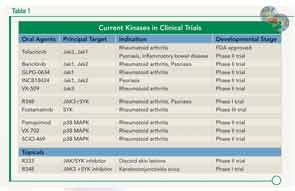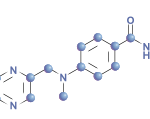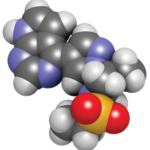Other Kinases
Splenic tyrosine kinase (Syk) is a cytoplasmic tyrosine kinase expressed predominately in hematopoietic tissues including osteoclasts that associates directly with surface receptors, including B cell receptors, Fcgamma receptors on macrophages, mast cells, and neutrophils. A SYK inhibitor, fostamatinib, has completed phase II studies demonstrating significant ACR 20/50/70 responses at doses of 100–150-mg b.i.d., better than placebo in the setting of background MTX.8 Results from its phase III studies (OSKIRA) were announced on June 4, and based on the findings, AstraZeneca has decided not to proceed with regulatory filings for fostamatinib. The studies looked at the effect of fostamatinib on RA patients with inadequate responses to DMARDs including MTX, as well as patients who fail a single anti-TNF therapy. Side effects of abnormal liver function tests, diarrhea, and neutropenia were seen, but in contrast to JAK inhibitors, an unexplained increase in blood pressure occurred. SYK inhibition may have benefit in systemic lupus erythematosus since it has the flexibility to affect B-cell receptor activation.
Other JAK/SYK inhibitor compounds for topical use are currently under investigation for treatment of active discoid lupus as well as ophthalmic preparations for keratoconjunctivitis sicca.
Unfortunately, clinical trials looking at inhibitors of p38MAPK have been disappointing. This serine-threonine kinase upon activation leads to production of TNF-α, IL-1, and IL-6 by monocytes. Despite its initial promise, phase II trials of pamapimod, VX-702+MTX demonstrated no benefit over the placebo arm despite improvement in CRP levels.9 Future studies of additional kinases will help elicit a better understanding of the complex coding mechanisms of regulation of both innate and adaptive immune systems. Hopefully, this will translate to greater selectivity of these agents, fine tuning their effect and minimizing adverse events.
The two-faced nature of the mythological god contrasts our future with our past experiences with other pharmaceutical agents. Further use in heterogeneous populations of RA with close scrutiny of safety will aid the clinician to determine the proper placement of these new small-molecule therapies in the treatment of RA.
Dr. Parks is medical director of rheumatology clinics and professor of medicine at Washington University School of Medicine in St. Louis.
References
- Laurence A, Pesu M, Silvennoinen O, O’Shea J. JAK kinases in health and disease: An update. Open Rheumatol J. 2012;6:232-244.
- Seavey MM, Dobrzanski P. The many faces of Janus kinase. Biochem Pharmacol. 2012;83:1136-1145.
- Fleischmann R, Kremer J, Cush J, et al. Placebo-controlled trial of tofacitinib monotherapy in rheumatoid arthritis. N Engl J Med. 2012;367:495-507.
- Cohen S, Krishnaswami S, Benda B, et al. Tofacitinib, an oral Janus kinase inhibitor: Analyses of efficacy and safety of 10 versus 5 mg twice daily in a pooled phase 3 and long-term extension rheumatoid arthritis population [Abstract 2485]. Arthritis Rheum. 2102;64 (Suppl.):S1048.
- Burmester GR, Blanco R, Charles-Schoeman C. Short and long term efficacy of tofacitinib, an oral Janus kinase inhibitor, in the treatment of patients with RA and an inadequate response to TNF inhibitors: Analyses of pooled phase 2, phase 3, and long term extension studies [Abstract L12]. Arthritis Rheum. 2102;64:4172.
- Lee EB, Fleischmann RM, Hall S, et al. Radiographic, clinical and functional comparison of tofacitinib monotherapy versus methotrexate in methotrexate-naive patients with rheumatoid arthritis. [Abstract 2486]. Arthritis Rheum. 2102;64 (Suppl.):S1049.
- Winthrop KL, Valdez H, Mortensen E, et al. Herpes zoster and tofacitinib therapy in patients with rheumatoid arthritis [Abstract 2490]. Arthritis Rheum. 2102;64 (Suppl.):S1051.
- Morales-Torres J. The status of fostamatinib in the treatment of rheumatoid arthritis. Expert Rev Clin Immunol. 2012;8:609-615.
- Kyttaris VC. Kinase inhibitors: A new class of antirheumatic drugs. Drug Des Devel Ther. 2012;6:245-250.



